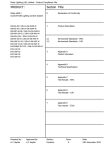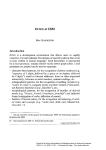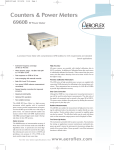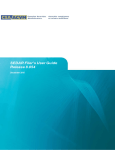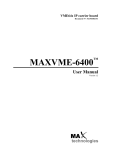Download A USER'S GUIDE TO THE NPL MONTHLY BULLETINS
Transcript
-1- A USER’S GUIDE TO THE NPL MONTHLY BULLETINS Contents 1. Introduction........................................................................................................................2 2. Off-Air Standard-Frequency and Time Signals.................................................................2 3. How Can I Obtain the Monthly Bulletins? ........................................................................3 4. The Monthly Bulletin for MSF ..........................................................................................4 5. The Monthly Bulletin for Droitwich................................................................................10 6. The Monthly Bulletin for GPS.........................................................................................16 7. The Monthly Bulletin for the BIPM Circular T...............................................................20 8. Contacting NPL ...............................................................................................................23 Appendix A. Coordinated Universal Time ..............................................................................24 Appendix B. Modified Julian Day ...........................................................................................25 © Crown Copyright May 2006 Reproduced by permission of the Controller of HMSO National Physical Laboratory | Hampton Road | Teddington | Middlesex | United Kingdom | TW11 0LW Switchboard 020 8977 3222 | NPL Helpline 020 8943 6880 | Fax 020 8943 6458 | www.npl.co.uk -2- 1. Introduction Each month the Time, Frequency and the Metre Group at NPL issues a set of four bulletins of time and frequency measurements. Three of the bulletins contain measurements from NPL’s monitoring systems for different off-air signals: MSF on 60 kHz, Droitwich on 198 kHz and GPS. The fourth contains results from the BIPM’s publication Circular T. The Monthly Bulletins are intended for users of these signals in industry and business who require either traceability from the off-air signals to NPL’s standards for time and frequency, or a record of problems affecting transmission of the signals. This User’s Guide provides background information about the signals reported in the Monthly Bulletins and explains how to interpret and use the measurements that they contain. 2. Off-Air Standard-Frequency and Time Signals There is a range of broadcast signals that can be received in the UK which provide access to either a reference frequency or a time code, or both. Three of these signals are monitored continuously at NPL against the atomic clocks that form the national time scale. This time scale, called UTC(NPL), is adjusted to keep both its time and its scale interval (ie. the duration of its one-second intervals) close to those of the international time scale Coordinated Universal Time, UTC (see Appendix A for more information). The signals monitored at NPL are the MSF standard-frequency and time service on 60 kHz, the 198 kHz signal broadcast from Droitwich, and the signals from the Global Positioning System (GPS) navigation satellites. Later sections of the User Guide give more information about each of these signals and explain how to interpret and utilise the content of the corresponding Monthly Bulletin. It is possible to receive other signals in the UK that can be used as either a time source or a frequency reference, such as the transmissions on 100 kHz from the Loran-C navigation system and the German standard-frequency and time signal DCF-77, but these broadcasts are not observed continuously by NPL. The fourth Monthly Bulletin is called the BIPM Circular T Summary. The Circular T is a monthly publication from the International Bureau of Weights and Measures (BIPM) that gives the offset between each national time scale, such as UTC(NPL), and UTC over the preceding month. The Circular T and the related Monthly Bulletin will be described in more detail in Section 7 below. National Physical Laboratory | Hampton Road | Teddington | Middlesex | United Kingdom | TW11 0LW Switchboard 020 8977 3222 | NPL Helpline 020 8943 6880 | Fax 020 8943 6458 | www.npl.co.uk -3- 3. How Can I Obtain the Monthly Bulletins? The Monthly Bulletins can be obtained from NPL in two ways. • The Monthly Bulletins are distributed free of charge to subscribers by e-mail. The Bulletins are sent as attachments in the widely-used PDF format. Users can choose to receive a monthly e-mail either with all four Bulletins attached, or with just the GPS and BIPM Bulletins attached if they have no interest in the LF signals. To sign up to receive the Monthly Bulletins in this way, go to the Bulletins web page, www.npl.co.uk/time/bulletins/ and follow the link to the on-line subscription form. • The Monthly Bulletins can also be downloaded directly from the NPL web site. They can be found by going to the www.npl.co.uk/time/bulletins/ page and following the link to Bulletin Archives. National Physical Laboratory | Hampton Road | Teddington | Middlesex | United Kingdom | TW11 0LW Switchboard 020 8977 3222 | NPL Helpline 020 8943 6880 | Fax 020 8943 6458 | www.npl.co.uk -4- 4. The Monthly Bulletin for MSF What signal is being observed? The MSF service is the UK’s only dedicated time and standard-frequency radio signal. Broadcast from Rugby Radio Station until the end of March 2007 and subsequently from Anthorn Radio Station in Cumbria, the service is operated by NPL and funded largely by the Department of Trade and Industry. The MSF signal carries a binary code with 2 data bits every second except the first in each minute. The code conveys UK time-of-day, date and other information. It also incorporates a time marker each second which is maintained correct at the transmitter to within ±1 ms. The code is monitored both at the radio station and off-air by NPL to ensure that the specification is met, and is therefore not reported in the Bulletins. Further information about the MSF service, including a detailed description of the time and date code, can be found in the NPL web site at www.npl.co.uk/time. The MSF 60 kHz carrier frequency is controlled by one of two atomic clocks at the radio station, and is adjusted when necessary to keep it within ±2 parts in 1012 of the nominal value. For many users this level of accuracy is sufficient, but for applications where greater accuracy is needed, or a knowledge of the frequency offset from UTC(NPL), the Monthly Bulletin for MSF provides the additional information required. It is important to note that the MSF carrier is not transmitted continuously. During the first second of each minute the carrier amplitude is reduced to zero for 500 ms, and in the remaining seconds it is turned off for 100 ms, then may be on or off for the two data bits which are each of 100 ms duration. MSF off-air frequency standards therefore utilise an oscillator which is phase-locked to the received carrier frequency with a time constant of at least several seconds, so that the periods when the carrier is off are not observed. NPL utilises a pair of receivers that operate in this way, producing a continuous 60 kHz output which is phase-locked to the received carrier. The outputs from these receivers are measured against a reference 1 pulse-per-second signal with a known offset from UTC(NPL) derived from one of the atomic clocks at NPL. A schematic diagram of part of the monitoring system is shown in figure 1. National Physical Laboratory | Hampton Road | Teddington | Middlesex | United Kingdom | TW11 0LW Switchboard 020 8977 3222 | NPL Helpline 020 8943 6880 | Fax 020 8943 6458 | www.npl.co.uk -5- Antenna 60 kHz Radio Station UTC(NPL) MSF Receiver 12:34:56 CounterTimer 1PPS 60 kHz Figure 1. Schematic diagram showing one of the MSF receivers at NPL and the method by which its 60 kHz output is compared with a 1 pulse-per-second signal related to UTC(NPL). The data reported in the MSF Bulletins are extracted from the measurement results logged by the monitoring systems. These time interval measurements are carried out automatically at regular intervals, normally every 3 minutes, and each recorded value is an average of 30 readings. Figure 2 shows schematically the measurements being made by the counter-timer: the time interval between the rising edge of a 1 pulse-per-second signal related to UTC(NPL) and the next positive-going zero crossing of the sine wave signal phase-locked to the received carrier. The maximum time interval that can be measured in this way is equal to the period of the MSF carrier, about 16.7 µs. The monitoring software is able to keep track of the phase jumps that occur as the carrier frequency varies and to calculate a cumulative value. As a result the phase offsets reported in the MSF Bulletin are normally much greater than the carrier’s period. National Physical Laboratory | Hampton Road | Teddington | Middlesex | United Kingdom | TW11 0LW Switchboard 020 8977 3222 | NPL Helpline 020 8943 6880 | Fax 020 8943 6458 | www.npl.co.uk -6- Time Interval Measured by Counter-Timer 1PPS Signal From UTC(NPL) Sine-Wave Signal From Receiver Figure 2. Schematic diagram showing the time interval measurements being made in each of the monitoring systems at NPL between a 1PPS signal related to UTC(NPL) and a sine wave signal phase-locked to the received carrier. The measurement of UTC(NPL)-MSF taken at 12 h UTC each day is extracted for the Bulletin. An average value of all of the measurements taken during a day would be misleading as the 60 kHz signal is considerably less stable in phase at dawn and dusk, and to a lesser extent during the night, than it is in the daylight hours. During the day, the “ground wave” component of the 60 kHz signal predominates, taking a predictable path that follows the Earth’s surface from the transmitter to the receiver and hence having a stable phase. At dusk and dawn, the component of the signal reflected off the ionosphere increases significantly, taking a longer and less predictable path and causing fluctuations in the received phase. Sampling the phase around midday, when the ionospheric component or “sky wave” is weakest, therefore gives the best measurements of the carrier phase and frequency. National Physical Laboratory | Hampton Road | Teddington | Middlesex | United Kingdom | TW11 0LW Switchboard 020 8977 3222 | NPL Helpline 020 8943 6880 | Fax 020 8943 6458 | www.npl.co.uk -7An example of the MSF Bulletin NATIONAL PHYSICAL LABORATORY Time and Frequency Services Division for Enabling Metrology Teddington, Middx, United Kingdom TW11 0LW Telephone: 020 8943 6880 Facsimile: 020 8943 6529 E-mail: [email protected] _________________________________ N P L M S F B u l l e t i n _________________________________ No.06-03 MJD Date March 2006 UTC(NPL)-MSF(60 kHz) 12h UTC (microseconds) 53795 53796 53797 53798 53799 2006-03-01 2006-03-02 2006-03-03 2006-03-04 2006-03-05 -73.2 -73.3 -73.5 -73.8 -74.1 53800 53801 53802 53803 53804 2006-03-06 2006-03-07 2006-03-08 2006-03-09 2006-03-10 -74.4 -74.5 -74.9 -75.2 -75.6 53805 53806 53807 53808 53809 2006-03-11 2006-03-12 2006-03-13 2006-03-14 2006-03-15 -76.0 -76.5 -77.6 -78.6 -73.7 53810 53811 53812 53813 53814 2006-03-16 2006-03-17 2006-03-18 2006-03-19 2006-03-20 -73.8 -73.8 -73.7 -73.6 -73.6 53815 53816 53817 53818 53819 2006-03-21 2006-03-22 2006-03-23 2006-03-24 2006-03-25 -73.7 -73.6 -73.5 -73.5 -73.5 53820 53821 53822 53823 53824 2006-03-26 2006-03-27 2006-03-28 2006-03-29 2006-03-30 -73.5 -73.5 -73.5 -78.1 -78.0 53825 2006-03-31 -78.1 (a)(b)(1) (a)(2) (a)(3) (b)(4) (a) at least one interruption in received carrier since the previous reading (b) at least one discontinuity in received phase since the previous reading ## reading not available (1) The MSF signal was off-air with a phase discontinuity (2) The MSF signal was off-air (3) The MSF signal was off-air (4) Carrier phase step of -4.7 on 2006-03-14 between 13:36 UTC and when transmission was restored. on 2006-03-17 between 07:19 UTC and on 2006-03-27 between 17:27 UTC and microseconds at approximately 14:40 13:39 UTC, 07:23 UTC. 17:31 UTC. UTC on 2006-03-28. National Physical Laboratory | Hampton Road | Teddington | Middlesex | United Kingdom | TW11 0LW Switchboard 020 8977 3222 | NPL Helpline 020 8943 6880 | Fax 020 8943 6458 | www.npl.co.uk -8- The box above shows a typical example of an MSF Monthly Bulletin, in this case for March 2006. Following the header with our contact details is the main section of the Bulletin consisting of three columns. The first two columns give the date, both as Modified Julian Day (MJD – see Appendix B) and in the standard year-month-day format. The third column gives the daily measurement results in microseconds, to a precision of 0.1 µs, followed by additional characters that indicate problems with the signal during that day. Below the data are explanations of the characters used to identify reception problems, which are also discussed in more detail below, followed by additional information about specific problems with the signal such as interruptions to the transmission or phase jumps. How to interpret the Bulletin The MSF Monthly Bulletin provides one reading per day, taken at 12:00 UTC. These values are phase differences: they represent the phase offset between UTC(NPL) and the MSF carrier. In practice, UTC(NPL) is represented by a 1 pulse-per-second (1PPS) signal, and the measurement performed is the time interval between the leading edge of the pulse and the next zero crossing of the continuous 60 kHz signal generated by the MSF receiver which is phase-locked to the received carrier. Figure 2 illustrates this measurement. The actual value of the phase difference is arbitrary – it depends on a large number of factors such as the propagation time of the signal and the delays within the cables and receiver at NPL. The significant parameter is the CHANGE in the phase delay from day to day, as this is a measure of the frequency difference between UTC(NPL) and MSF. It can therefore be applied as a correction to the output from an MSF-locked frequency standard to correct the frequency difference between MSF and UTC(NPL). Two examples are given below. Example 1: calculating a monthly average value for the MSF frequency offset. Taking the first and last results within the March 2006 Bulletin, the mean frequency offset of the MSF carrier over the period can be calculated from: ∆f [(UTC(NPL)-MSF] = [(final result) – (initial result)] µs/day No. days = [(-78.1) – (-73.2)] x10-6 29x86400 = -1.95 x10-12 where the minus sign indicates that the frequency of MSF is higher than that of UTC(NPL). Example 2: calculating a daily average value for the MSF frequency offset. It is possible to use the equation in example 1 to calculate the frequency offset using results from adjacent days, or a small number of days apart. In general however it is preferable to calculate the average over the whole month or a large part of it, because of the limited precision of the individual results. National Physical Laboratory | Hampton Road | Teddington | Middlesex | United Kingdom | TW11 0LW Switchboard 020 8977 3222 | NPL Helpline 020 8943 6880 | Fax 020 8943 6458 | www.npl.co.uk -9- It is important to check before calculating a frequency offset from the MSF Bulletin that there has not been a phase jump or frequency change in the MSF signal during the period. This is indicated by the symbols (a) and (b) placed to the right of the data column in the Bulletin, which are explained in the text below the data. The symbol (a) denotes that there has been at least one interruption in the MSF carrier received at NPL at some time since the previous reading. For example, the (a) appearing to the right of the data line for MJD 53809 indicates that the MSF signal was interrupted at some time between 12h UTC on MJD 53808 and 12 h UTC on MJD 53809. The symbol (b) denotes that there was at least one discontinuity in the phase of the MSF carrier received at NPL since the previous reading. For example, the (b) appearing to the right of the data line for MJD 53809 indicates that there was a phase jump in the MSF carrier at some time between 12 h UTC on MJD 53808 and 12 h UTC on MJD 53809. The period selected for a calculation of the MSF frequency offset should not include the time of this event. When possible, additional notes are added to the MSF Bulletin to provide more information about off-air periods, phase jumps or other problems with the service. These are referred to by numbers such as (1) appearing with the symbols (a) and (b). Occasionally technical problems result in measurements being unavailable. These events are shown in the Bulletin by the symbol ## in place of the missing data. National Physical Laboratory | Hampton Road | Teddington | Middlesex | United Kingdom | TW11 0LW Switchboard 020 8977 3222 | NPL Helpline 020 8943 6880 | Fax 020 8943 6458 | www.npl.co.uk - 10 - 5. The Monthly Bulletin for Droitwich What signal is being observed? The radio station at Droitwich transmits a signal on 198 kHz that broadcasts BBC Radio 4 Long Wave to England and Wales. Two other lower-power transmitters, at Westerglen and Burghhead, provide coverage over Scotland. The transmitters are operated by National Grid Wireless. The Droitwich 198 kHz carrier frequency is controlled by one of a pair of rubidium frequency standards located at the radio station, providing good stability. The frequency is adjusted when necessary to keep it normally within ±1 part in 1011 of the correct value, which combined with the predictable propagation characteristics of low frequency signals has resulted in it being widely used as a standard frequency. The 198 kHz transmissions carry a low bit-rate data service for customers such as the electricity supply industry. Data is transmitted at 25 bits per second by means of linear phase modulation of the carrier by up to ±22.5°. A data bit is represented by biphase modulation – phase advance then retard, or retard then advance – so that the phase modulation is symmetrical about the nominal rest position of the carrier and over a whole number of data bits there is no perturbation of the carrier frequency. The carrier frequency of the signal is monitored continuously by NPL in a similar way to MSF. Two off-air receivers each produce a continuous 198 kHz output by phase-locking an oscillator to the received carrier frequency with a time constant of several seconds. The outputs from these receivers are measured against a reference 1 pulse-per-second signal with a known offset from UTC(NPL) derived from one of the atomic clocks at NPL, in the same way as for MSF. A schematic diagram of part of the monitoring system is shown in figure 3. National Physical Laboratory | Hampton Road | Teddington | Middlesex | United Kingdom | TW11 0LW Switchboard 020 8977 3222 | NPL Helpline 020 8943 6880 | Fax 020 8943 6458 | www.npl.co.uk - 11 - Antenna 198 kHz Radio Station UTC(NPL) Droitwich Receiver 12:34:56 CounterTimer 1PPS 198 kHz Figure 3. Schematic diagram showing one of the Droitwich receivers at NPL and the method by which its 198 kHz output is compared with a 1 pulse-per-second signal related to UTC(NPL). The data reported in the Droitwich Bulletins are extracted from the measurement results logged by the monitoring system. As with MSF, these time interval measurements are carried out automatically by the monitoring system at regular intervals, normally every 3 minutes, and each recorded value is an average of 30 readings. Figure 2 shows schematically the measurements being made by the counter-timer, which are essentially the same as for MSF: the time interval is measured between the rising edge of a 1 pulse-per-second signal related to UTC(NPL) and the next positive-going zero crossing of the sine wave signal phase-locked to the received carrier. As with the MSF signal, the maximum time interval that can be measured by the countertimer is equal to the period of the Droitwich carrier, about 5.05 µs. The monitoring software is able to keep track of the phase jumps that occur as the carrier frequency varies and to calculate a cumulative value. As a result the phase offsets reported in the Droitwich Bulletin are normally much greater than the carrier’s period. The Droitwich Bulletin differs from the MSF Bulletin in that, for historical reasons, two measurements of UTC(NPL)-Droitwich are reported for each day. These are the measurements taken at 12 h UTC and at 15 h UTC. An average value of all of the measurements taken during a day would be misleading as the 198 kHz signal is considerably less stable in phase at dawn and dusk, and to a lesser extent National Physical Laboratory | Hampton Road | Teddington | Middlesex | United Kingdom | TW11 0LW Switchboard 020 8977 3222 | NPL Helpline 020 8943 6880 | Fax 020 8943 6458 | www.npl.co.uk - 12 during the night, than it is in the daylight hours. During the day, the “ground wave” component of the signal predominates, taking a predictable path that follows the Earth’s surface from the transmitter to the receiver and hence having a stable phase. At dusk and dawn, the component of the signal reflected off the ionosphere increases significantly, taking a longer and less predictable path and causing fluctuations in the received phase. Sampling the phase around midday and in mid-afternoon, when the ionospheric component or “sky wave” is weak, therefore gives the best measurements of the carrier phase and frequency. National Physical Laboratory | Hampton Road | Teddington | Middlesex | United Kingdom | TW11 0LW Switchboard 020 8977 3222 | NPL Helpline 020 8943 6880 | Fax 020 8943 6458 | www.npl.co.uk - 13 An example of the Droitwich Bulletin NATIONAL PHYSICAL LABORATORY Time and Frequency Services Division for Enabling Metrology Teddington, Middx, United Kingdom TW11 0LW Telephone: 020 8943 6880 Facsimile: 020 8943 6529 E-mail: [email protected] NPL operates two NTP servers that provide Internet Time Service to users outside NPL. The servers are synchronised using NTP over the NPL local area network to two other servers, _____________________________________________ which are themselves synchronised to 1 pulse-per-second signals derived from NPL’s atomic P public L Dservers R O Iare T therefore W I C H classed B uaslstratum l e t 2,i but n they are controlled by a clocks. NThe _____________________________________________ highly reliable source of time – the UK national time scale UTC(NPL) - that is traceable directly to UTC and independent ofMarch GPS. 2006 No.06-03 MJD The NPL Internet Time Servers can be accessed by specifying their host name or IP address. UTC(NPL)-Droitwich(198 kHz) UTC(NPL)-Droitwich(198 kHz) TheseDate addresses are given in the table below. Name 53795 53796 53797 53798 53799 2006-03-01 2006-03-02 2006-03-03 2006-03-04 2006-03-05 12h UTC (microseconds) How to Interpret The Bulletin Host (DNS) Name -255.1 -271.7 -288.9 -305.6 -322.4 15h UTC (microseconds) IP Address -257.0 -273.7 -291.0 -307.5 -324.7 53800 2006-03-06 -337.2 -338.6 53801 2006-03-07 -350.9 -352.4 53802 2006-03-08 -366.8 -368.9 53803 2006-03-09 -382.3 -384.3 53804 Any 2006-03-10 -391.9 -393.0 computer with Internet access and running a suitable NTP client program should be able 53805 53806 53807 53808 53809 to 2006-03-11 call the NPL ITS servers. NPL does not provide such a program as there-401.9 is already a wide -400.8 2006-03-12 -410.9 range of NTP software available-409.8 from many different sources, including a number of 2006-03-13 -419.0 -420.1 freeware programs that can be -428.3 downloaded over the internet. However, the following 2006-03-14 -429.4 guidance may be of help. 2006-03-15 -437.7 -438.9 53810 53811 53812 53813 53814 2006-03-16 -447.3 -448.5 • If your PC is running Windows XP Home Edition, SNTP capability-458.0 is already built2006-03-17 -456.8 2006-03-18 -467.6 in. It can be set up easily by-466.3 following these instructions: 2006-03-19 -475.4 -476.5 a. Click on the “Start” button at the bottom left of the screen and select “Control 2006-03-20 -484.5 -485.6 53815 53816 53817 53818 53819 2006-03-21 -494.6 b. If you have chosen-493.5 to use the Classic View, click on “Date and Time” and 2006-03-22 -502.6 -503.7 Time” tab, or if you are using the Category View, click on 2006-03-23 select the “Internet -511.6 -512.7 2006-03-24 “Date, Time, Language -520.7 & Regional Options” then “Change-521.8 Date and Time”, 2006-03-25 then “Internet Time”. -535.5 -537.6 53820 53821 53822 53823 53824 c. The address of the -552.9 selected NTP server, such as ntp1.npl.co.uk, can then be 2006-03-26 -555.0 2006-03-27 entered, and if desired -570.7 -572.9 tested using the “Update Now” button. 2006-03-28 -588.1 -590.4 d. Make sure that the “Automatically synchronize with an Internet time(b) server” 2006-03-29 -605.3 (b) -606.6 box is checked. 2006-03-30 -606.9 -606.8 53825 2006-03-31 Panel”. e. Click on the “OK” button to implement the changes. -606.2 -606.0 (a) at least one interruption in received carrier since the previous reading (b) at least one discontinuity in received phase since the previous reading ## reading not available National Physical Laboratory | Hampton Road | Teddington | Middlesex | United Kingdom | TW11 0LW Switchboard 020 8977 3222 | NPL Helpline 020 8943 6880 | Fax 020 8943 6458 | www.npl.co.uk - 14 The box above shows a typical example of a Droitwich Monthly Bulletin, in this case for March 2006. Following the header with our contact details is the main section of the Bulletin consisting of four columns. The first two columns give the date, both as Modified Julian Day (MJD – see Appendix B) and in the standard year-month-day format. The third column gives the daily measurement results taken at 12:00 UTC, and the fourth column gives the measurements taken at 15:00 UTC. The measurement values are in microseconds, to a precision of 0.1 µs, and may be followed by additional characters that indicate problems with the signal during that day. Below the data are explanations of the characters used to identify reception problems, which are also discussed in more detail below. How to interpret the Bulletin The Droitwich Monthly Bulletin provides two readings per day, taken at 12:00 UTC and at 15:00 UTC. These values are phase differences: they represent the phase offset between UTC(NPL) and the Droitwich carrier. In practice, UTC(NPL) is represented by a 1 pulse-persecond (1PPS) signal, and the measurement performed is the time interval between the leading edge of the pulse and the next zero crossing of the continuous 198 kHz signal generated by a Droitwich receiver which is phase-locked to the received carrier. Figure 2 illustrates this measurement. The actual value of the phase difference is arbitrary – it depends on a large number of factors such as the propagation time of the signal and the delays within the cables and receiver at NPL. The significant parameter is the CHANGE in the phase delay from day to day, as this is a measure of the frequency difference between UTC(NPL) and Droitwich. It can therefore be applied as a correction to the output from a Droitwich-locked frequency standard to correct the frequency difference between Droitwich and UTC(NPL). Two examples are given below. Example 1: calculating a monthly average value for the Droitwich frequency offset. Using the 12:00 UTC results from the March 2006 Bulletin taken on 1 March and 28 March, the mean frequency offset of the Droitwich carrier over the period can be calculated from: ∆f [(UTC(NPL)- Droitwich] = [(final result) – (initial result)] µs/day No. days = [(-588.1) – (-255.1)] x10-6 27x86400 = -1.43 x10-10 where the minus sign indicates that the frequency of Droitwich is higher than that of UTC(NPL). Note that this result is not typical, and the frequency of the Droitwich carrier is normally within ±1x10-11 of the correct value. Example 2: calculating a daily average value for the Droitwich frequency offset. It is possible to use the equation in example 1 to calculate the frequency offset using results from adjacent days, or a small number of days apart. In general however it is National Physical Laboratory | Hampton Road | Teddington | Middlesex | United Kingdom | TW11 0LW Switchboard 020 8977 3222 | NPL Helpline 020 8943 6880 | Fax 020 8943 6458 | www.npl.co.uk - 15 preferable to calculate the average over the whole month or a large part of it, because of the limited precision of the individual results. It is important to check before calculating a frequency offset from the Droitwich Bulletin that there has not been a phase jump or frequency change in the Droitwich signal during the period. This is indicated by the symbols (a) and (b), placed to the right of either of the data columns in the Bulletin. The symbol (a) denotes that there has been at least one interruption in the Droitwich carrier received at NPL at some time since the previous reading. For example (not shown in the Bulletin), an (a) appearing to the right of the12:00 UTC measurement for MJD 53809 would indicate that the Droitwich signal was interrupted at some time between 12h UTC on MJD 53808 and 12 h UTC on MJD 53809. Similarly, an (a) appearing to the right of the 15:00 UTC measurement for MJD 53809 would indicate that the Droitwich signal was interrupted at some time between 15 h UTC on MJD 53808 and 15 h UTC on MJD 53809. The symbol (b) denotes that there was at least one discontinuity in the phase of the MSF carrier received at NPL since the previous reading. For example, the (b) appearing to the right of the 12:00 UTC measurement for MJD 53823 indicates that there was a phase jump in the Droitwich carrier at some time between 12 h UTC on MJD 53822 and 12 h UTC on MJD 53823. Similarly, the (b) appearing to the right of the 15:00 UTC measurement for MJD 53823 indicates that there was a phase jump in the Droitwich carrier at some time between 15 h UTC on MJD 53822 and 152 h UTC on MJD 53823. The period selected for a calculation of the MSF frequency offset should not include the time of this event. In example 1 above, the frequency offset was calculated between 1 March and 28 March for this reason. Occasionally technical problems result in measurements being unavailable. These events are shown in the Bulletin by the symbol ## in place of the missing data. National Physical Laboratory | Hampton Road | Teddington | Middlesex | United Kingdom | TW11 0LW Switchboard 020 8977 3222 | NPL Helpline 020 8943 6880 | Fax 020 8943 6458 | www.npl.co.uk - 16 - 6. The Monthly Bulletin for GPS What signals are being observed? The Global Positioning System, or GPS, is a navigation satellite system operated by the United States Department of Defense. Some of the satellite signals are encrypted for military purposes but others are open and available to civilian users. The GPS satellite constellation consists of a minimum of 24 satellites in orbits with a period of 11 h 58 min. The orbits are arranged in six orbital planes, each inclined at 55º with respect to the equatorial plane. At any location on the Earth's surface signals can be received from typically 5 to 12 GPS satellites. The basic principle of operation of GPS is straightforward. Each GPS satellite contains at least one on-board atomic clock, either caesium or rubidium. Ground tracking stations monitor the satellite clock offsets from GPS system time, along with the orbital parameters of the satellite, and send this information to the satellites. The navigation message broadcast by each satellite includes the time of transmission as well as the clock offset, and can be decoded by GPS receivers on the ground. A receiver measures the time offset between each satellite signal and its own internal clock, providing an estimate of the distance to that satellite from the time of flight. By simultaneously timing the signals received from four or more satellites it is possible to calculate four unknowns: the antenna coordinates in three dimensions, and the difference between the clock in the receiver and the satellite clock or GPS time. GPS system time is adjusted to keep it synchronised with UTC (see Appendix A), but does not have leap seconds applied so is offset from UTC by an integral number of seconds (14 from January 2006) plus a small correction. Two separate coded GPS signals are transmitted at different frequencies: L1 at 1575.42 MHz and L2 at 1227.60 MHz. The shorter coarse/ acquisition (C/A) code is transmitted at the L1 frequency only, while the longer more precise P-code is transmitted at both the L1 and L2 frequencies, known as P1 and P2 respectively. Dual frequency operation enables the user to implement a measured ionospheric correction. The P-code is encrypted (Anti-Spoofing), which denies civilian users access to the content, but the ranging information is the same on both frequencies and can be extracted by a correlator inside the receiver. NPL operates several GPS receivers of two basic types. Time and Frequency Solutions TimeTrace common-view receivers provide single frequency measurements of the offsets between a reference 1PPS signal related to UTC(NPL) and the individual satellite clocks. Their data can be combined with similar measurements at a remote location to derive the time difference between the two reference signals on the ground. Both the primary and the backup common-view receivers have had their internal delays calibrated and their reference coordinates optimized to facilitate a smooth switching between them in the event of a failure. The second type of receiver is dual frequency and observes both the coded satellite signals and the carrier phases to provide greater accuracy and stability. Two are in use at NPL: an Ashtech Z12-T (which is registered as an IGS station, NPLD) and a Javad Legacy. NPL is therefore able to monitor the GPS time signals against a stable, accurate and independent time scale in order to validate the signals received off-air. The GPS common-view monitoring receivers at NPL measure and report on the time difference between GPS system time and UTC(NPL) for up to eight GPS satellites every sixteen minutes. The raw data is processed to give a daily average value for UTC(NPL)National Physical Laboratory | Hampton Road | Teddington | Middlesex | United Kingdom | TW11 0LW Switchboard 020 8977 3222 | NPL Helpline 020 8943 6880 | Fax 020 8943 6458 | www.npl.co.uk - 17 GPS_Time, which is published in the GPS Bulletins. Any anomalous GPS satellite clock readings are also logged and reported in the Bulletins. National Physical Laboratory | Hampton Road | Teddington | Middlesex | United Kingdom | TW11 0LW Switchboard 020 8977 3222 | NPL Helpline 020 8943 6880 | Fax 020 8943 6458 | www.npl.co.uk - 18 An example of the GPS Bulletin NATIONAL PHYSICAL LABORATORY Time and Frequency Services Division for Enabling Metrology Teddington, Middx, United Kingdom TW11 0LW Telephone: 020 8943 6880 Facsimile: 020 8943 6529 E-mail: [email protected] _________________________________ N P L G P S B u l l e t i n _________________________________ No.06-03 March 2006 MJD Date 53795 53796 53797 53798 53799 2006-03-01 2006-03-02 2006-03-03 2006-03-04 2006-03-05 -31.7 -34.4 -33.6 -33.8 -34.0 53800 53801 53802 53803 53804 2006-03-06 2006-03-07 2006-03-08 2006-03-09 2006-03-10 -33.9 -36.0 -37.2 -38.2 -36.8 53805 53806 53807 53808 53809 2006-03-11 2006-03-12 2006-03-13 2006-03-14 2006-03-15 -36.2 -35.5 -36.2 -37.2 -37.0 53810 53811 53812 53813 53814 2006-03-16 2006-03-17 2006-03-18 2006-03-19 2006-03-20 -39.3 -39.3 -38.2 -41.4 -42.8 53815 53816 53817 53818 53819 2006-03-21 2006-03-22 2006-03-23 2006-03-24 2006-03-25 -46.2 -48.6 -49.7 -47.6 -47.0 53820 53821 53822 53823 53824 2006-03-26 2006-03-27 2006-03-28 2006-03-29 2006-03-30 -46.2 -46.2 -46.1 -44.0 -45.7 53825 2006-03-31 -45.3 NOTE NOTE NOTE NOTE NOTE NOTE "#" means that NPL's data is not available. The total 95% confidence interval on each daily value is +/-22ns. Due to leap seconds, [UTC(NPL) - GPS_time] div 1s = -14s this month. UTC(NPL)-GPS_time = [UTC(NPL)-GPS_time] div 1s + [UTC(NPL)-GPS_time] mod 1s Expressed in words, total difference = leap seconds + column data. This report has been compiled by GPSMONITOR107.EXE version 1.07. 1: 2: 3: 4: 5: 6: [UTC(NPL) - GPS_time] mod 1s (ns) National Physical Laboratory | Hampton Road | Teddington | Middlesex | United Kingdom | TW11 0LW Switchboard 020 8977 3222 | NPL Helpline 020 8943 6880 | Fax 020 8943 6458 | www.npl.co.uk - 19 - The box above shows a typical example of a GPS Monthly Bulletin, in this case for March 2006. Following the header with our contact details is the main section of the Bulletin consisting of three columns. The first two columns give the date, both as Modified Julian Day (MJD – see Appendix B) and in the standard year-month-day format. The third column gives the daily measurement results, representing a mean value over the day of the time difference UTC(NPL)-GPS_Time. The measurement values are in nanoseconds, to a precision of 0.1 ns. Below the data are several notes that provide additional information about the results. Any anomalous signals observed from the GPS satellites during the month are also reported. How to interpret the Bulletin The NPL GPS Bulletin is intended primarily for those operating GPS receivers as time and frequency standards in stand-alone mode, and it can be used for two distinct purposes: • • To quantify the accuracy of the GPS timing signals received in the UK against UTC(NPL); To validate the integrity of the GPS timing signals received in the UK. GPS receivers that provide some form of precise time output are generally some form of GPS-disciplined oscillator (GPSDO), which steers an internal oscillator using the decoded GPS satellite signals to keep the device’s time output close to GPS Time. A good GPSDO may achieve an accuracy of around 100 ns or better. A GPSDO provides a time output that may be adjusted to GPS_Time or to an approximation of UTC. The data contained in the Bulletin provides a correction between GPS_Time and UTC(NPL), allowing users to calculate their time offset from UTC(NPL) or to demonstrate traceability to NPL. The notes at the end of the Bulletin provide a summary of any faults in the GPS system or anomalies in the signals received by NPL, and can be used to demonstrate the integrity of the time content of the GPS signals. National Physical Laboratory | Hampton Road | Teddington | Middlesex | United Kingdom | TW11 0LW Switchboard 020 8977 3222 | NPL Helpline 020 8943 6880 | Fax 020 8943 6458 | www.npl.co.uk - 20 - 7. The Monthly Bulletin for the BIPM Circular T What is the BIPM Circular T? The Monthly Bulletins for MSF, Droitwich and GPS provide the offsets between the respective off-air signals and the UK national time scale UTC(NPL). They can also be used as a formal means of demonstrating traceability from a received signal to UTC(NPL). A small number of users instead require the offset, or a method of traceability, between an off-air signal and UTC (see Appendix A for more information about UTC). The fourth Monthly Bulletin, for the BIPM Circular T, provides the additional information required to do so. The BIPM publishes a Circular T around the middle of each calendar month, containing results for the preceding month. Circular T is divided into several sections, the first of which lists the offsets between UTC and each national time scale UTC(k) at 5-day intervals. The offsets are by convention given at 0 h UTC on MJDs ending in 4 or 9 (see Appendix B for more about the MJD). The NPL Bulletin simply contains the results taken from Circular T for the difference UTC-UTC(NPL). Because the NPL Monthly Bulletins are often published before the BIPM Circular T is issued, the Circular T Bulletin contains the values taken from the Circular T published during the preceding month. In other words, for example, whereas the March 2006 MSF, Droitwich and GPS Bulletins contain measurements taken during March, the Circular T Bulletin contains the values for UTC-UTC(NPL) during February. However, the Circular T Bulletins also give links to the BIPM web site, and these can be used to obtain more recent Circular T data when they have been issued. National Physical Laboratory | Hampton Road | Teddington | Middlesex | United Kingdom | TW11 0LW Switchboard 020 8977 3222 | NPL Helpline 020 8943 6880 | Fax 020 8943 6458 | www.npl.co.uk - 21 An example of the Circular T Bulletin NATIONAL PHYSICAL LABORATORY Time and Frequency Services Division for Enabling Metrology Teddington, Middx, United Kingdom TW11 0LW Telephone: 020 8943 6880 Facsimile: 020 8943 6529 E-mail: [email protected] ________________________________________________ B I P M C i r c u l a r T S u m m a r y ________________________________________________ No. T218 S e c t i o n 1 MJD Date 53764 53769 53774 53779 53784 53789 53794 2006-01-29 2006-02-03 2006-02-08 2006-02-13 2006-02-18 2006-02-23 2006-02-28 March 2006 : UTC-UTC(NPL) UTC-UTC(NPL) (nanoseconds) 28.2 26.6 29.3 27.0 30.8 29.4 28.1 NOTE : The BIPM Circular T is available at the BIPM web site. Address: http://www.bipm.org/en/home/ FTP server: http://www1.bipm.org/en/scientific/tai/time_ftp.html#publication The box above shows a typical example of a Monthly Bulletin for the BIPM Circular T, in this case for March 2006. Following the header with our contact details is the main section of the Bulletin consisting of three columns. The first two columns give the date, both as Modified Julian Day (MJD – see Appendix B) and in the standard year-month-day format. The third column gives the time difference UTC-UTC(NPL) calculated by the BIPM at 5day intervals, to a precision of 0.1 ns. These time offset values are calculated at 0 h UTC on the specified dates, which are those MJDs falling within the month that have 4 or 9 as their final digit. In addition, the first line of data repeats the last line from the previous Circular T. National Physical Laboratory | Hampton Road | Teddington | Middlesex | United Kingdom | TW11 0LW Switchboard 020 8977 3222 | NPL Helpline 020 8943 6880 | Fax 020 8943 6458 | www.npl.co.uk - 22 Below the data are the addresses of the BIPM web site and of the FTP server of the BIPM time group. The latter provides access to the latest issue of Circular T as soon as it is published, as well as an archive of back issues. How to interpret the Circular T Bulletin The purpose of the values given in the Bulletin is to allow measurements made against a national time scale such as UTC(NPL) to be corrected to give the offset from UTC. The process is straightforward except for the need to interpolate the Circular T results to the time of the measurement. Example 1: correction for time offset. Let us suppose a result has been obtained for the time interval between a reference signal and UTC(NPL), for instance using the NPL GPS Bulletin, at 12:00 UTC on MJD 53785. It is possible to fit a curve to the Circular T values but generally a simple linear fit is adequate. In this example, the correction to apply is: UTC-UTC(NPL) = 30.8 + 1.5x(29.4 – 30.8) ns = 30.4 ns 5 Example 2: correction for frequency offset. The frequency difference between UTC and UTC(NPL) is given by the gradient of a plot of the Circular T results. If two adjacent results in Circular T were the same, the mean value of the frequency difference between UTC and UTC(NPL) would have been zero over that 5-day period. Taking the same measurement time of midday on MJD 53785, the frequency difference is approximately equal to: ∆f [UTC-UTC(NPL)] = (29.4 – 30.8)x10-9 = -3.2x10-15 5x86400 where the minus sign indicates that UTC(NPL) is higher in frequency than UTC averaged over this 5-day period. Again a somewhat more precise result can be obtained by fitting a polynomial to the Circular T results, but the simpler calculation is adequate for most purposes. National Physical Laboratory | Hampton Road | Teddington | Middlesex | United Kingdom | TW11 0LW Switchboard 020 8977 3222 | NPL Helpline 020 8943 6880 | Fax 020 8943 6458 | www.npl.co.uk - 23 - 8. Contacting NPL NPL welcomes feedback about its services. If you have any questions or comments regarding the NPL Monthly Bulletins, including suggestions for improvements, please contact us by email, telephone, fax or letter. Our contact details are given below. Time and Frequency Services Division for Enabling Metrology National Physical Laboratory Hampton Road Teddington Middlesex TW11 0LW Telephone: Facsimile: E-mail: Web-site: 020 8943 6880 020 8943 6458 [email protected] www.npl.co.uk/time National Physical Laboratory | Hampton Road | Teddington | Middlesex | United Kingdom | TW11 0LW Switchboard 020 8977 3222 | NPL Helpline 020 8943 6880 | Fax 020 8943 6458 | www.npl.co.uk - 24 - Appendix A. Coordinated Universal Time A single time scale based on atomic clocks is used world-wide as the basis for all precise time-keeping. The time scale is called Coordinated Universal Time, abbreviated to UTC. All of the broadcast time codes and standard frequencies that can be received off-air in the UK are traceable back to UTC. The MSF time and date code conveys UTC in winter and UTC+1 hour in summer when British Summer Time (BST) is in effect. UTC is generated by the International Bureau of Weights and Measures (BIPM - Bureau International des Poids et Mesures) located in Paris. Each month the BIPM processes data from around 250 atomic clocks located at some 55 national measurement institutes around the world to form a time scale with high stability. The duration of the scale interval is adjusted using results from a small number of primary frequency standards to maintain it as close as possible to the SI second, the basic unit of time. The result is a continuous, step-free atomic time scale called International Atomic Time (TAI). Because of small random variations in the Earth’s rotation, TAI gradually diverges from Universal Time (UT1), a time scale based on the mean duration of the solar day and a more precisely defined version of Greenwich Mean Time. A second atomic time scale – UTC - is therefore generated for practical use. UTC is a compromise time scale that offers the accuracy and stability of TAI while staying in approximate agreement with UT1. Since the current form of UTC was adopted in 1972, the seconds of the UTC time scale have been exactly aligned with those of TAI so that the two scales differ by an integer number of seconds. Leap second adjustments are made to UTC when required to keep it with 0.9 seconds of UT1. UT1 is maintained by the International Earth Rotation and Reference Systems Service (IERS) and it is they who decide when leap second adjustments should be applied. The effect of a leap second is identical to setting UTC forwards or backwards by one second. For example, UTC might change from being 0.6 seconds ahead of UT1 to being 0.4 seconds behind after a positive leap second has been introduced. Following the leap second introduced at the end of December 2005, UTC was exactly 33 seconds behind TAI. The procedures for maintaining UTC are described by an International Telecommunication Union Recommendation (ITU-R Recommendation TF.460). Because UTC is processed in monthly blocks it is not available in real time. Instead, each national measurement institute that contributes clock data to the BIPM maintains its own national time scale, such as UTC(NPL), that serves as an available realisation of UTC. These so-called UTC(k) time scales are adjusted to keep their offsets from UTC reasonably small, typically less than 100 ns, using the information published in the BIPM Circular T to determine the required corrections. National Physical Laboratory | Hampton Road | Teddington | Middlesex | United Kingdom | TW11 0LW Switchboard 020 8977 3222 | NPL Helpline 020 8943 6880 | Fax 020 8943 6458 | www.npl.co.uk - 25 - Appendix B. Modified Julian Day Dates are given in the Monthly Bulletins in two formats. The first column uses the Modified Julian Day number (MJD), while the second gives the standard year-month-day format. This Appendix provides some background information about the Modified Julian Day. The Julian Date (JD) was developed by the astronomer John Herschel in 1849 to give a simple integer count of days, which followed the astronomical convention in use at that time of running from noon to noon. The Julian day number provides a convenient and simple basis for reconciling disparate historical calendars and it is independent of the sometimes complex rules of the various calendars still in use. The Julian Date uses an origin of 1 January 4713 BC, which was devised in 1583 by Joseph Justus Scaliger from calculations of the birth date of Christ. The day starting at noon on 2000 January 1 was therefore JD 2451545. The Julian day number is inconveniently large for most purposes and the change of date at midday does not conform with other methods of reckoning time. The modified Julian day number, or MJD, was therefore adopted by the Smithsonian Astrophysical Observatory in 1957. It is defined as Julian Day minus 2 400 000.5, with the fractional part changing the start of the day from noon to midnight. It provides a simple five-decimal-digit day count that can be used whenever appropriate, and is now widely employed in areas of science such as timekeeping and astronomy. Its origin is at 0 h UT on 1858 November 17, so, for example, 2006 January 1 is MJD 53736. The fractional part of the day is now sometimes included to specify time-of-day, for example MJD 53736.25 to represent 06:00 UTC on that day, and MJD is then generally referred to as Modified Julian Date. National Physical Laboratory | Hampton Road | Teddington | Middlesex | United Kingdom | TW11 0LW Switchboard 020 8977 3222 | NPL Helpline 020 8943 6880 | Fax 020 8943 6458 | www.npl.co.uk

























